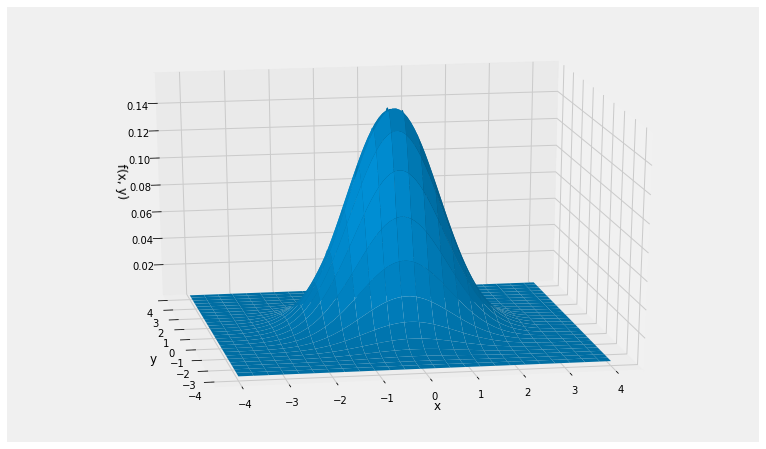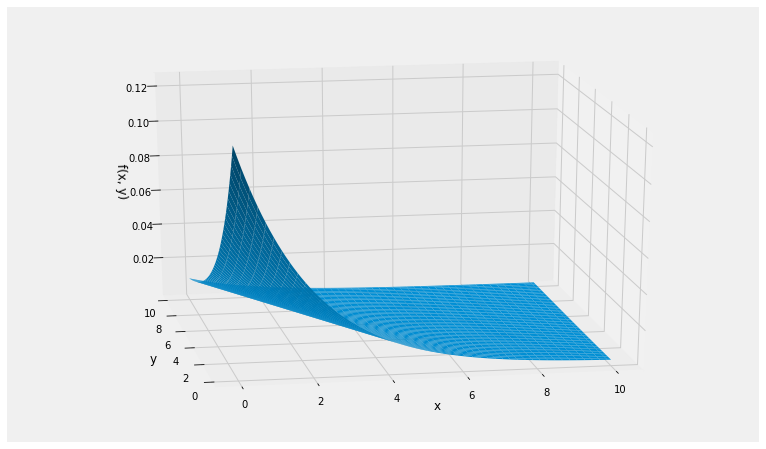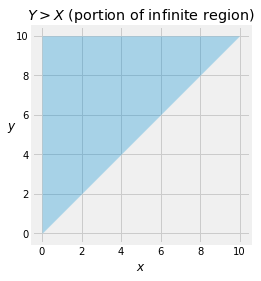Independence
Jointly distributed random variables X and Y are independent if P(X∈A,Y∈B)=P(X∈A)P(Y∈B) for all intervals A and B.
Let X have density fX, let Y have density fY, and suppose X and Y are independent. Then if f is the joint density of X and Y,
f(x,y)dxdy∼P(X∈dx,Y∈dy)=P(X∈dx)P(Y∈dy) (independence)=fX(x)dxfY(y)dy=fX(x)fY(y)dxdyThus if X and Y are independent then their joint density is given by
f(x,y)=fX(x)fY(y)This is the product rule for densities: the joint density of two independent random variables is the product of their densities.
Independent Standard Normal Random Variables
Suppose X and Y are i.i.d. standard normal random variables. Then their joint density is given by
f(x,y)=1√2πe−12x2⋅1√2πe−12y2, −∞<x,y<∞Equivalently, f(x,y)=12πe−12(x2+y2), −∞<x,y<∞
Here is a graph of the joint density surface.
def indep_standard_normals(x,y):
return 1/(2*math.pi) * np.exp(-0.5*(x**2 + y**2))
Plot_3d((-4, 4), (-4, 4), indep_standard_normals, rstride=4, cstride=4)

Notice the circular symmetry of the surface. This is because the formula for the joint density involves the pair (x,y) through the expression x2+y2 which is symmetric in x and y.
Notice also that P(X=Y)=0, as the probability is the volume over a line. This is true of all pairs of independent random variables with a joint density: P(X=Y)=0. So for example P(X>Y)=P(X≥Y). You don’t have to worry about whether or not to the inequality should be strict.
The Larger of Two Independent Exponential Random Variables
Let X and Y be independent random variables. Suppose X has the exponential (λ) distribution and Y has the exponential (μ) distribution. The goal of this example is to find P(Y>X).
By the product rule, the joint density of X and Y is given by
f(x,y) = λe−λxμe−μy, x>0, y>0The graph below shows the joint density surface in the case λ=0.5 and μ=0.25, so that E(X)=2 and E(Y)=4.
def independent_exp(x, y):
return 0.5 * 0.25 * np.e**(-0.5*x - 0.25*y)
Plot_3d((0, 10), (0, 10), independent_exp)

To find P(Y>X) we must integrate the joint density over the upper triangle of the first quadrant, a portion of which is shown below.

The probability is therefore P(Y>X) = ∫∞0∫∞xλe−λxμe−μydydx
We can do this double integral without much calculus, just by using probability facts.
P(Y>X)=∫∞0∫∞xλe−λxμe−μydydx=∫∞0λe−λx(∫∞xμe−μydy)dx=∫∞0λe−λxe−μxdx (survival function of Y, evaluated at x)=λλ+μ∫∞0(λ+μ)e−(λ+μ)xdx=λλ+μ (total integral of exponential (λ+μ) density is 1)Thus
P(Y>X) = λλ+μAnalogously,
P(X>Y) = μλ+μNotice that the two chances are proportional to the parameters. This is consistent with intuition if you think of X and Y as two lifetimes. If λ is large, the corresponding lifetime X is likely to be short, and therefore Y is likely to be larger than X as the formula implies.
If λ=μ then P(Y>X)=1/2 which you can see by symmetry since P(X=Y)=0.
If we had attempted the double integral in the other order – first x, then y – we would have had to do more work. The integral is
∫∞0∫y0λe−λxμe−μydxdyLet’s take the easy way out by using SymPy to confirm that we will get the same answer.
# Create the symbols; they are all positive
x = Symbol('x', positive=True)
y = Symbol('y', positive=True)
lamda = Symbol('lamda', positive=True)
mu = Symbol('mu', positive=True)
# Construct the expression for the joint density
f_X = lamda * exp(-lamda * x)
f_Y = mu * exp(-mu * y)
joint_density = f_X * f_Y
joint_density
# Display the integral – first x, then y
Integral(joint_density, (x, 0, y), (y, 0, oo))
# Evaluate the integral
answer = Integral(joint_density, (x, 0, y), (y, 0, oo)).doit()
answer
# Confirm that it is the same
# as what we got by integrating in the other order
simplify(answer)
